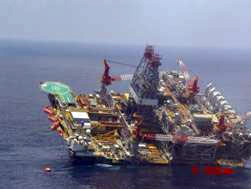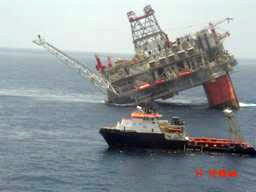Wednesday, July 13, 2005 10:31:54 PM

BP Plc. is breathing a bit easier Wednesday, two days after its giant
Thunder Horse oil rig was found listing precariously in the wake of Hurricane
Dennis. While BP said it is too early to say how long it will take to
get the $1 billion rig back on an even keel, but reported it at least
appears to have stabilized "There has been no worsening of the situation
for the last two days" a BP spokesman at BP's Houston office.
An initial survey of the rig's pontoons showed no damage, an indication
it probably was not damaged by debris torn adrift by the storm. But how
a rig designed to withstand Gulf of Mexico hurricanes came to list so
severely remains a mystery. BP said it is still sifting through data collected
by sensors onboard to figure out what went wrong.
The rig was evacuated as a precaution ahead of the weekend hurricane
A salvage team was put on the platform Tuesday, restarting some of its
generators to begin pumping excess seawater out of the huge pontoons that
keep it afloat Initial surveillance photos of the crippled rig raised
concerns that righting it would push the Thunder Horse project past its
scheduled start-up in late 2005. "We have no estimate yet on how long it
will take to get it back upright," the BP spokesman said. "It's too early
to say what impact of this event will be on project schedule."
There was also speculation among offshore industry engineers that the
rig might sink, a fate that has befallen other semi-submersible rigs over
the years, most recently Petrobras' huge P-36 production platform that
went down off Brazil in 2001 following an onboard explosion BP is operator
of the Thunder Horse deepwater development projct with a 75% stake, with
Exxon Mobil Corp. holding the remaining 25%. Production from the field
is expected to reach about 250,000 barrels of oil and 200 million cubic
feet of natural gas by 2007 The giant semi-submersible production platform
is the centrepiece of the technologically cutting-edge project.
Semi-submersibles have been used for several decades, primarily for drilling
exploration wells as the industry pushes into ever deeper waters in the
search for oil and gas. What sets the Thunder Horse platform apart from
predecessors is its huge size. Its main work deck is the equivalent of
three football fields. The rig supports two drilling derricks and has
full accommodations for a crew of 229 that is ferried by helicopter.
Once on location, the giant rig's pontoons are deliberately flooded,
partially sinking it to provide a stable drilling platform and production
platform while 16 anchors embedded in the seabed 6,000 feet below hold
it in place.
The Thunder Horse platform was designed by GVA of Sweden and built at
South Korea's Daewoo Shipbuilding and Marine Engineering Okpo yard To
keep it all the lights, pumps and ventilation systems running, the platform
has a 100 megawatt power station on board, enough electricity to supply
a town of 80,000 homes. BP, in its corporate literature, calls the Thunder
Horse semi-submersible the "platform that for the next 25 years or more
will be the oil and gas production hub for the largest hydrocarbon discovery
to date in the Gulf of Mexico."
This story was supplied by MarketWatch.


|

